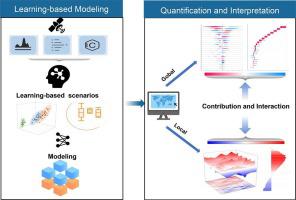当前位置:
X-MOL 学术
›
Sci. Total Environ.
›
论文详情
Our official English website, www.x-mol.net, welcomes your feedback! (Note: you will need to create a separate account there.)
Towards interpretable machine learning for observational quantification of soil heavy metal concentrations under environmental constraints
Science of the Total Environment ( IF 9.8 ) Pub Date : 2024-03-24 , DOI: 10.1016/j.scitotenv.2024.171931 Yishan Sun , Shuisen Chen , Hao Jiang , Boxiong Qin , Dan Li , Kai Jia , Chongyang Wang
Science of the Total Environment ( IF 9.8 ) Pub Date : 2024-03-24 , DOI: 10.1016/j.scitotenv.2024.171931 Yishan Sun , Shuisen Chen , Hao Jiang , Boxiong Qin , Dan Li , Kai Jia , Chongyang Wang

|
Monitoring heavy metal concentrations in soils is central to assessing agricultural production safety. Satellite observations permit inferring concentrations from spectrum, thereby contributing to the prevention and control of soil heavy metal pollution. However, heavy metals exhibit weak spectral responses, particularly at low and medium concentrations, and are predominantly influenced by other soil components. Machine learning (ML)-driven modelling can produce predictions but lacks interpretability. Here, we present an interpretable ML framework for concentration quantification modelling and investigated the contributions of spectral and environmental factors—pH and organic carbon—to the estimation of metals with multiple concentration gradients, as analysed through SHAP (SHapley Additive exPlanations) data derived from four learning-based scenarios. The results indicated that scenarios SHC (spectral, pH, and organic carbon) and SH (spectral and pH) were the most optimal for chromium (Cr) [RPD = 1.42, Adj R = 0.62], and cadmium (Cd) [RPD = 1.80, Adj R = 0.80]. Under environmental constraints, the spectral predictability for Cr and Cd was improved by 67 % and 87 %, respectively. We concluded that interpretable modelling, utilising both spectral and soil environmental factors, holds significant potential for estimating heavy metals across concentration gradients. It is recommended that samples with higher organic carbon content and lower pH be selected to enhance Cr and Cd predictions. An advanced grasp of interpretable predictions facilitates earlier warning of heavy metal contamination and guides the formulation of robust sampling strategies.
中文翻译:

走向可解释的机器学习,用于环境限制下土壤重金属浓度的观测量化
监测土壤中重金属浓度是评估农业生产安全的核心。卫星观测可以从光谱中推断浓度,从而有助于土壤重金属污染的防治。然而,重金属表现出较弱的光谱响应,特别是在低浓度和中等浓度下,并且主要受其他土壤成分的影响。机器学习 (ML) 驱动的建模可以产生预测,但缺乏可解释性。在这里,我们提出了一个用于浓度量化建模的可解释的机器学习框架,并研究了光谱和环境因素(pH 值和有机碳)对具有多个浓度梯度的金属估计的贡献,并通过来自四个浓度的 SHAP(SHapley Additive exPlanations)数据进行了分析。基于学习的场景。结果表明,情景 SHC(光谱、pH 和有机碳)和 SH(光谱和 pH)对于铬 (Cr) [RPD = 1.42,Adj R = 0.62] 和镉 (Cd) [RPD = 1.80,调整 R = 0.80]。在环境限制下,Cr 和 Cd 的光谱可预测性分别提高了 67% 和 87%。我们得出的结论是,利用光谱和土壤环境因素的可解释模型对于估计跨浓度梯度的重金属具有巨大的潜力。建议选择有机碳含量较高、pH 值较低的样品,以增强 Cr 和 Cd 的预测。对可解释预测的深入掌握有助于对重金属污染进行早期预警,并指导制定稳健的采样策略。
更新日期:2024-03-24
中文翻译:

走向可解释的机器学习,用于环境限制下土壤重金属浓度的观测量化
监测土壤中重金属浓度是评估农业生产安全的核心。卫星观测可以从光谱中推断浓度,从而有助于土壤重金属污染的防治。然而,重金属表现出较弱的光谱响应,特别是在低浓度和中等浓度下,并且主要受其他土壤成分的影响。机器学习 (ML) 驱动的建模可以产生预测,但缺乏可解释性。在这里,我们提出了一个用于浓度量化建模的可解释的机器学习框架,并研究了光谱和环境因素(pH 值和有机碳)对具有多个浓度梯度的金属估计的贡献,并通过来自四个浓度的 SHAP(SHapley Additive exPlanations)数据进行了分析。基于学习的场景。结果表明,情景 SHC(光谱、pH 和有机碳)和 SH(光谱和 pH)对于铬 (Cr) [RPD = 1.42,Adj R = 0.62] 和镉 (Cd) [RPD = 1.80,调整 R = 0.80]。在环境限制下,Cr 和 Cd 的光谱可预测性分别提高了 67% 和 87%。我们得出的结论是,利用光谱和土壤环境因素的可解释模型对于估计跨浓度梯度的重金属具有巨大的潜力。建议选择有机碳含量较高、pH 值较低的样品,以增强 Cr 和 Cd 的预测。对可解释预测的深入掌握有助于对重金属污染进行早期预警,并指导制定稳健的采样策略。



























 京公网安备 11010802027423号
京公网安备 11010802027423号